Tesco Share Price and Efficient Market Hypothesis Analysis
VerifiedAdded on 2020/11/23
|11
|2085
|297
Report
AI Summary
This report provides a comprehensive analysis of Tesco's share price, applying the Efficient Market Hypothesis to assess market efficiency. The study begins with an introduction to the Efficient Market Hypothesis, outlining its key concepts and variants, including weak, semi-strong, and strong forms. It then presents a detailed examination of Tesco's share price fluctuations over a two-year period, using monthly data to illustrate trends and calculate relevant financial metrics. The report applies the Efficient Market Hypothesis to the collected company data to determine the efficiency of the market and predict future share prices using the Random Walk method. Furthermore, the report reflects on significant events impacting Tesco's operational practices and their effects on sales and share value. The conclusion summarizes the findings and emphasizes the importance of understanding market efficiency for investment decisions.
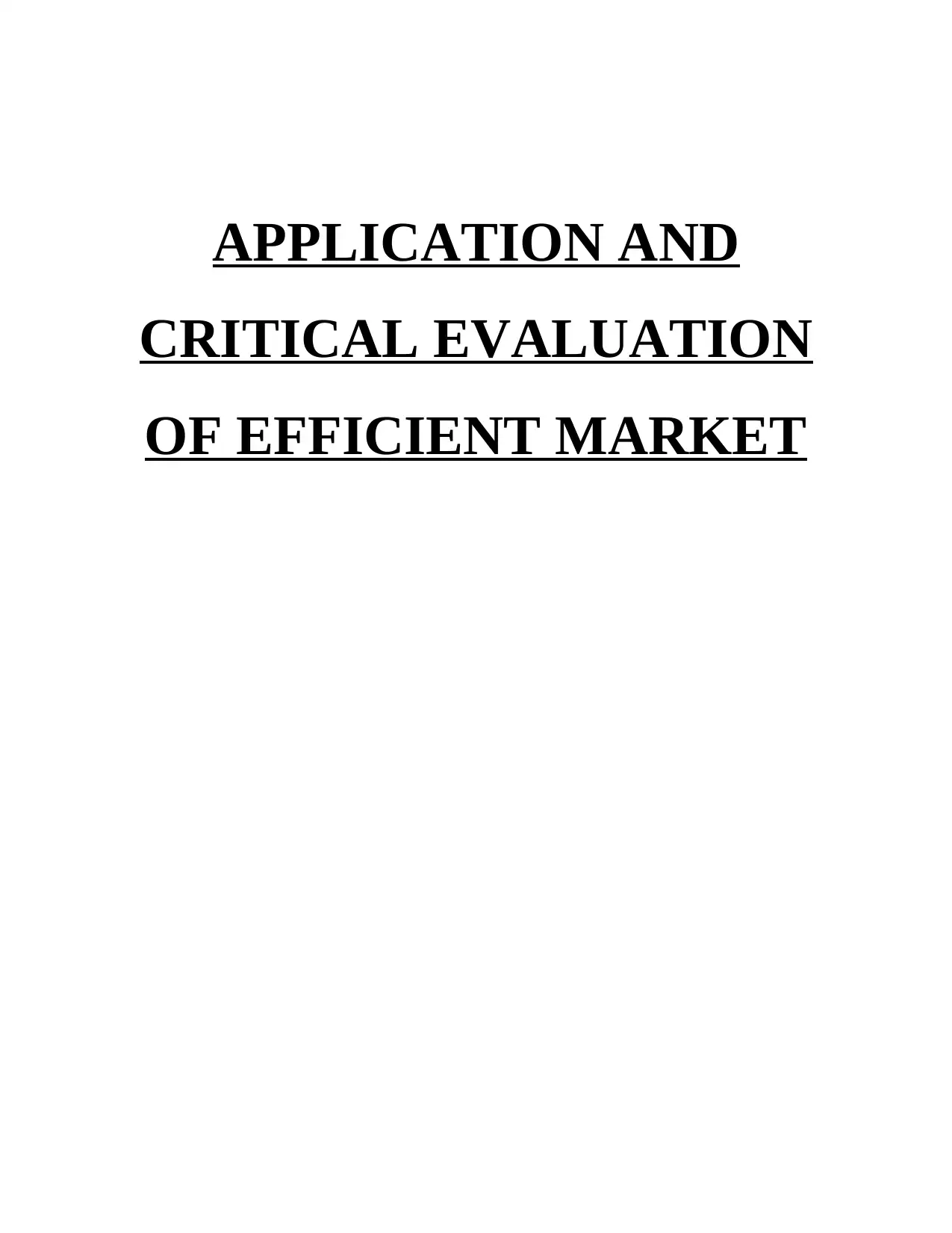
APPLICATION AND
CRITICAL EVALUATION
OF EFFICIENT MARKET
CRITICAL EVALUATION
OF EFFICIENT MARKET
Paraphrase This Document
Need a fresh take? Get an instant paraphrase of this document with our AI Paraphraser
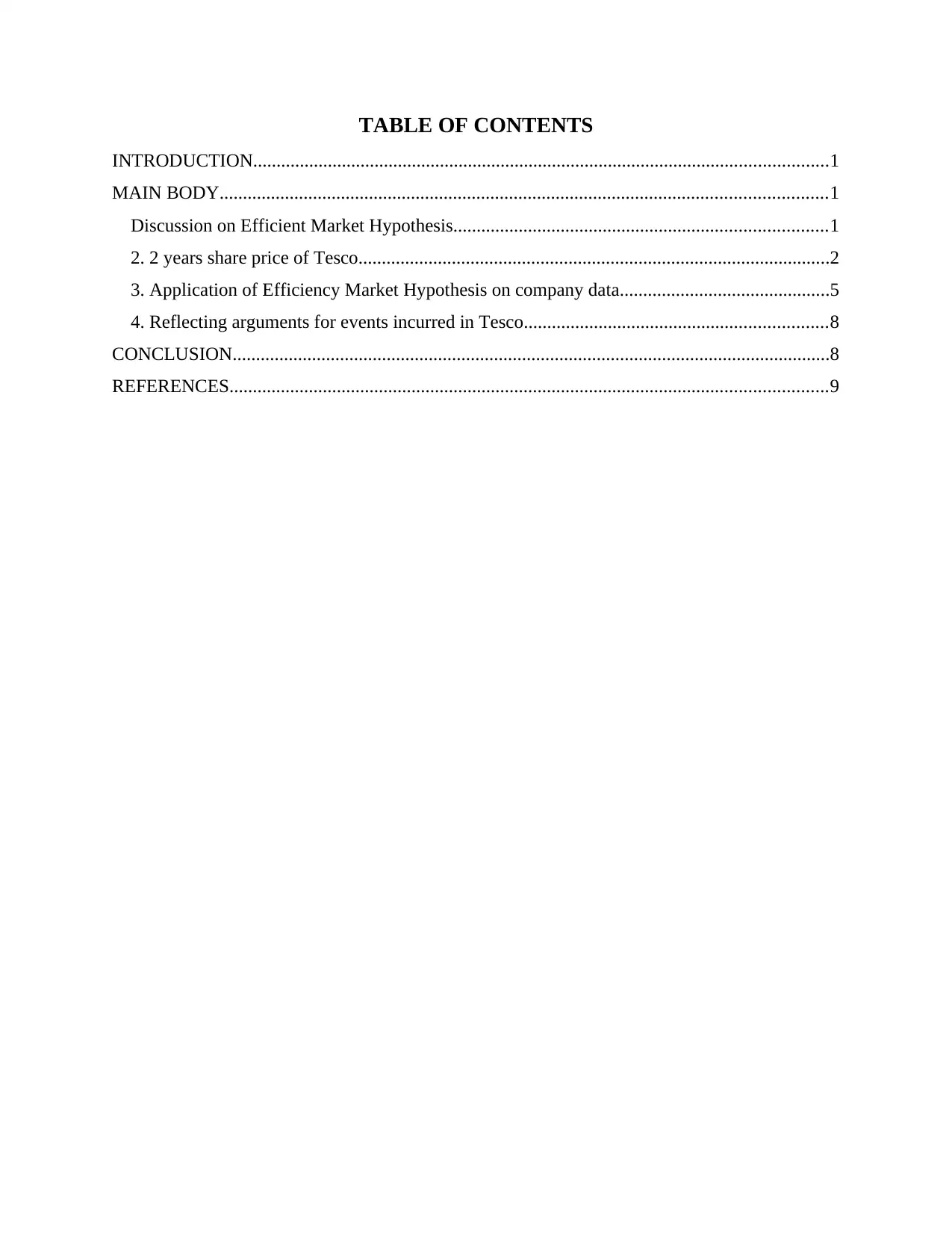
TABLE OF CONTENTS
INTRODUCTION...........................................................................................................................1
MAIN BODY..................................................................................................................................1
Discussion on Efficient Market Hypothesis................................................................................1
2. 2 years share price of Tesco.....................................................................................................2
3. Application of Efficiency Market Hypothesis on company data.............................................5
4. Reflecting arguments for events incurred in Tesco.................................................................8
CONCLUSION................................................................................................................................8
REFERENCES................................................................................................................................9
INTRODUCTION...........................................................................................................................1
MAIN BODY..................................................................................................................................1
Discussion on Efficient Market Hypothesis................................................................................1
2. 2 years share price of Tesco.....................................................................................................2
3. Application of Efficiency Market Hypothesis on company data.............................................5
4. Reflecting arguments for events incurred in Tesco.................................................................8
CONCLUSION................................................................................................................................8
REFERENCES................................................................................................................................9
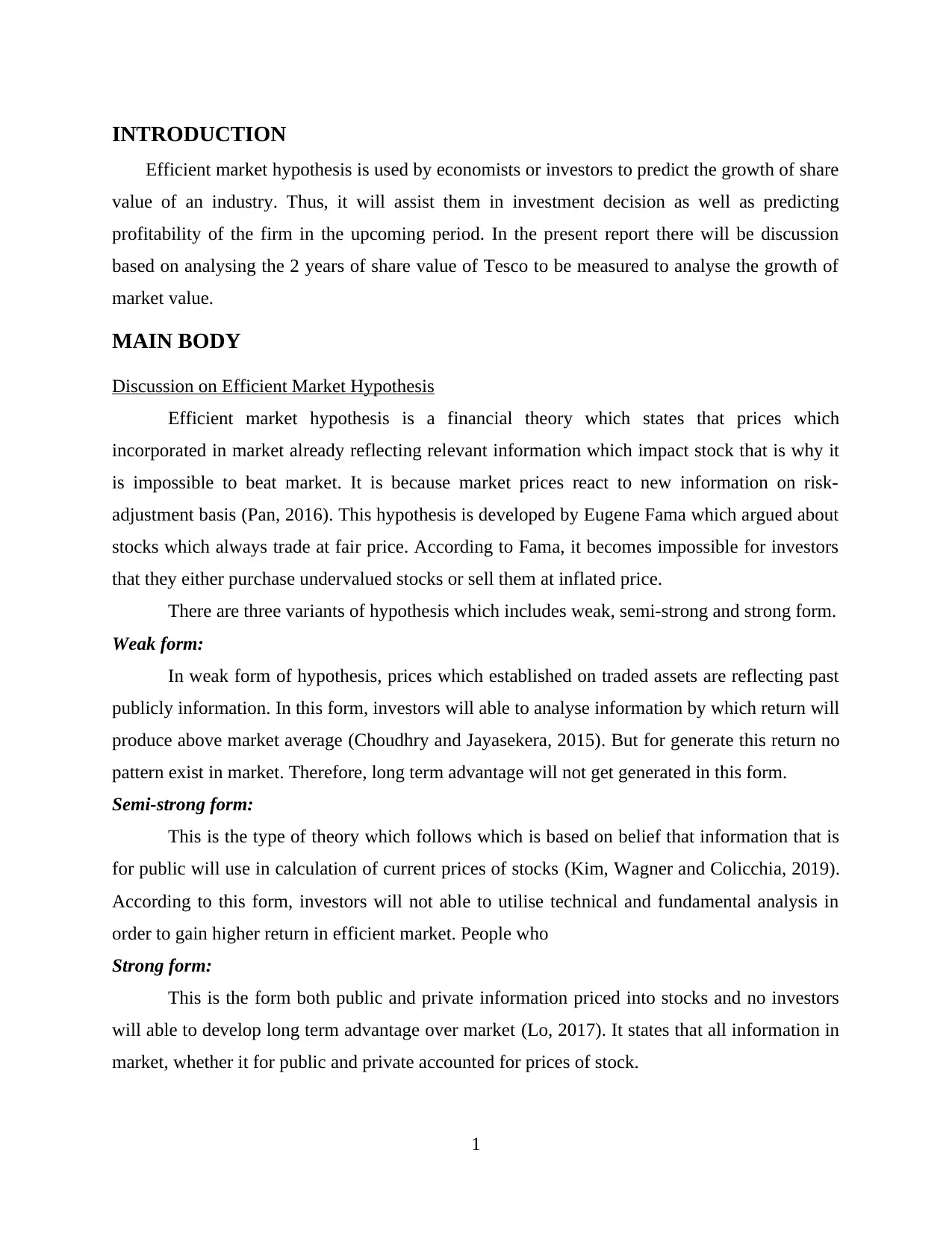
INTRODUCTION
Efficient market hypothesis is used by economists or investors to predict the growth of share
value of an industry. Thus, it will assist them in investment decision as well as predicting
profitability of the firm in the upcoming period. In the present report there will be discussion
based on analysing the 2 years of share value of Tesco to be measured to analyse the growth of
market value.
MAIN BODY
Discussion on Efficient Market Hypothesis
Efficient market hypothesis is a financial theory which states that prices which
incorporated in market already reflecting relevant information which impact stock that is why it
is impossible to beat market. It is because market prices react to new information on risk-
adjustment basis (Pan, 2016). This hypothesis is developed by Eugene Fama which argued about
stocks which always trade at fair price. According to Fama, it becomes impossible for investors
that they either purchase undervalued stocks or sell them at inflated price.
There are three variants of hypothesis which includes weak, semi-strong and strong form.
Weak form:
In weak form of hypothesis, prices which established on traded assets are reflecting past
publicly information. In this form, investors will able to analyse information by which return will
produce above market average (Choudhry and Jayasekera, 2015). But for generate this return no
pattern exist in market. Therefore, long term advantage will not get generated in this form.
Semi-strong form:
This is the type of theory which follows which is based on belief that information that is
for public will use in calculation of current prices of stocks (Kim, Wagner and Colicchia, 2019).
According to this form, investors will not able to utilise technical and fundamental analysis in
order to gain higher return in efficient market. People who
Strong form:
This is the form both public and private information priced into stocks and no investors
will able to develop long term advantage over market (Lo, 2017). It states that all information in
market, whether it for public and private accounted for prices of stock.
1
Efficient market hypothesis is used by economists or investors to predict the growth of share
value of an industry. Thus, it will assist them in investment decision as well as predicting
profitability of the firm in the upcoming period. In the present report there will be discussion
based on analysing the 2 years of share value of Tesco to be measured to analyse the growth of
market value.
MAIN BODY
Discussion on Efficient Market Hypothesis
Efficient market hypothesis is a financial theory which states that prices which
incorporated in market already reflecting relevant information which impact stock that is why it
is impossible to beat market. It is because market prices react to new information on risk-
adjustment basis (Pan, 2016). This hypothesis is developed by Eugene Fama which argued about
stocks which always trade at fair price. According to Fama, it becomes impossible for investors
that they either purchase undervalued stocks or sell them at inflated price.
There are three variants of hypothesis which includes weak, semi-strong and strong form.
Weak form:
In weak form of hypothesis, prices which established on traded assets are reflecting past
publicly information. In this form, investors will able to analyse information by which return will
produce above market average (Choudhry and Jayasekera, 2015). But for generate this return no
pattern exist in market. Therefore, long term advantage will not get generated in this form.
Semi-strong form:
This is the type of theory which follows which is based on belief that information that is
for public will use in calculation of current prices of stocks (Kim, Wagner and Colicchia, 2019).
According to this form, investors will not able to utilise technical and fundamental analysis in
order to gain higher return in efficient market. People who
Strong form:
This is the form both public and private information priced into stocks and no investors
will able to develop long term advantage over market (Lo, 2017). It states that all information in
market, whether it for public and private accounted for prices of stock.
1
⊘ This is a preview!⊘
Do you want full access?
Subscribe today to unlock all pages.

Trusted by 1+ million students worldwide
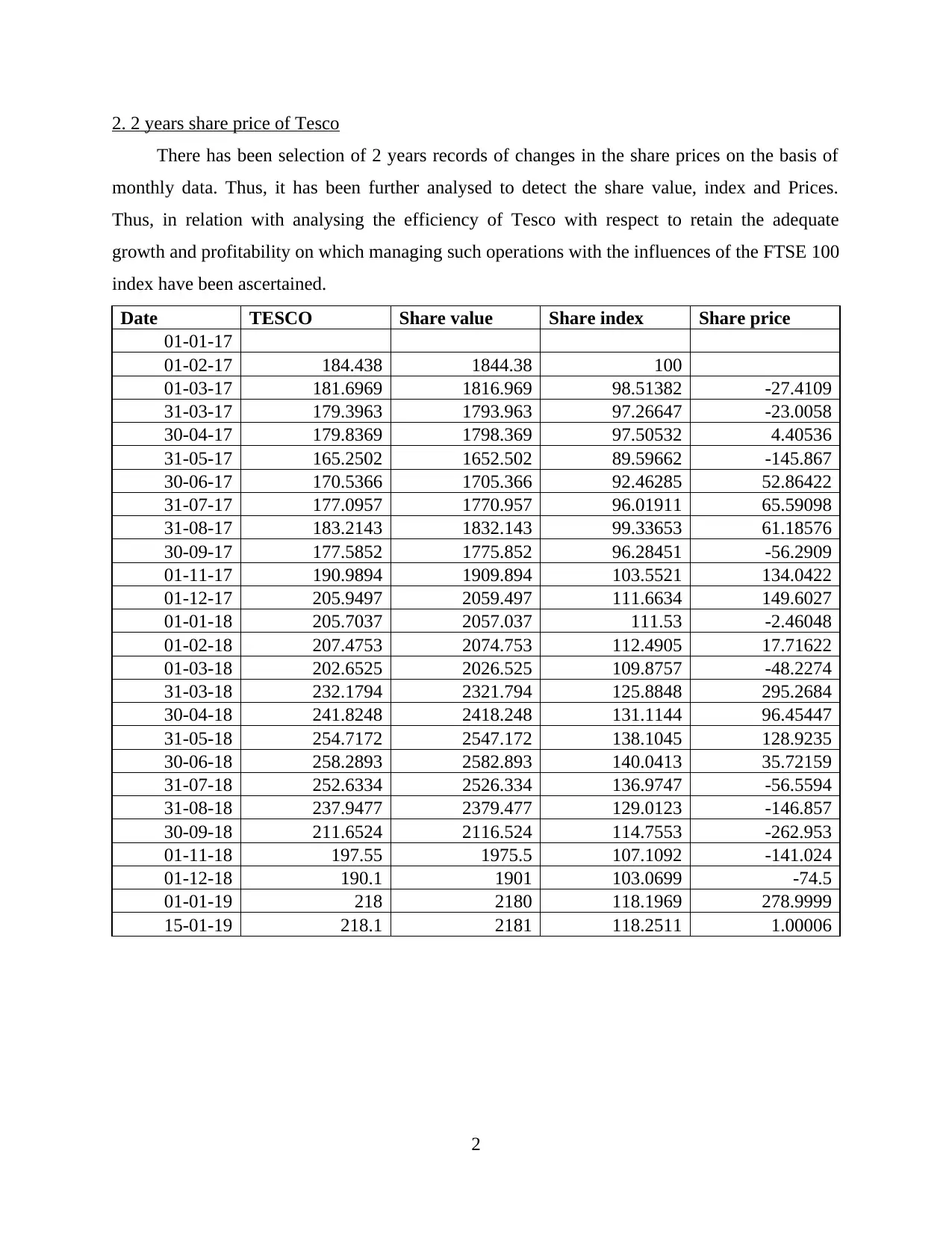
2. 2 years share price of Tesco
There has been selection of 2 years records of changes in the share prices on the basis of
monthly data. Thus, it has been further analysed to detect the share value, index and Prices.
Thus, in relation with analysing the efficiency of Tesco with respect to retain the adequate
growth and profitability on which managing such operations with the influences of the FTSE 100
index have been ascertained.
Date TESCO Share value Share index Share price
01-01-17
01-02-17 184.438 1844.38 100
01-03-17 181.6969 1816.969 98.51382 -27.4109
31-03-17 179.3963 1793.963 97.26647 -23.0058
30-04-17 179.8369 1798.369 97.50532 4.40536
31-05-17 165.2502 1652.502 89.59662 -145.867
30-06-17 170.5366 1705.366 92.46285 52.86422
31-07-17 177.0957 1770.957 96.01911 65.59098
31-08-17 183.2143 1832.143 99.33653 61.18576
30-09-17 177.5852 1775.852 96.28451 -56.2909
01-11-17 190.9894 1909.894 103.5521 134.0422
01-12-17 205.9497 2059.497 111.6634 149.6027
01-01-18 205.7037 2057.037 111.53 -2.46048
01-02-18 207.4753 2074.753 112.4905 17.71622
01-03-18 202.6525 2026.525 109.8757 -48.2274
31-03-18 232.1794 2321.794 125.8848 295.2684
30-04-18 241.8248 2418.248 131.1144 96.45447
31-05-18 254.7172 2547.172 138.1045 128.9235
30-06-18 258.2893 2582.893 140.0413 35.72159
31-07-18 252.6334 2526.334 136.9747 -56.5594
31-08-18 237.9477 2379.477 129.0123 -146.857
30-09-18 211.6524 2116.524 114.7553 -262.953
01-11-18 197.55 1975.5 107.1092 -141.024
01-12-18 190.1 1901 103.0699 -74.5
01-01-19 218 2180 118.1969 278.9999
15-01-19 218.1 2181 118.2511 1.00006
2
There has been selection of 2 years records of changes in the share prices on the basis of
monthly data. Thus, it has been further analysed to detect the share value, index and Prices.
Thus, in relation with analysing the efficiency of Tesco with respect to retain the adequate
growth and profitability on which managing such operations with the influences of the FTSE 100
index have been ascertained.
Date TESCO Share value Share index Share price
01-01-17
01-02-17 184.438 1844.38 100
01-03-17 181.6969 1816.969 98.51382 -27.4109
31-03-17 179.3963 1793.963 97.26647 -23.0058
30-04-17 179.8369 1798.369 97.50532 4.40536
31-05-17 165.2502 1652.502 89.59662 -145.867
30-06-17 170.5366 1705.366 92.46285 52.86422
31-07-17 177.0957 1770.957 96.01911 65.59098
31-08-17 183.2143 1832.143 99.33653 61.18576
30-09-17 177.5852 1775.852 96.28451 -56.2909
01-11-17 190.9894 1909.894 103.5521 134.0422
01-12-17 205.9497 2059.497 111.6634 149.6027
01-01-18 205.7037 2057.037 111.53 -2.46048
01-02-18 207.4753 2074.753 112.4905 17.71622
01-03-18 202.6525 2026.525 109.8757 -48.2274
31-03-18 232.1794 2321.794 125.8848 295.2684
30-04-18 241.8248 2418.248 131.1144 96.45447
31-05-18 254.7172 2547.172 138.1045 128.9235
30-06-18 258.2893 2582.893 140.0413 35.72159
31-07-18 252.6334 2526.334 136.9747 -56.5594
31-08-18 237.9477 2379.477 129.0123 -146.857
30-09-18 211.6524 2116.524 114.7553 -262.953
01-11-18 197.55 1975.5 107.1092 -141.024
01-12-18 190.1 1901 103.0699 -74.5
01-01-19 218 2180 118.1969 278.9999
15-01-19 218.1 2181 118.2511 1.00006
2
Paraphrase This Document
Need a fresh take? Get an instant paraphrase of this document with our AI Paraphraser
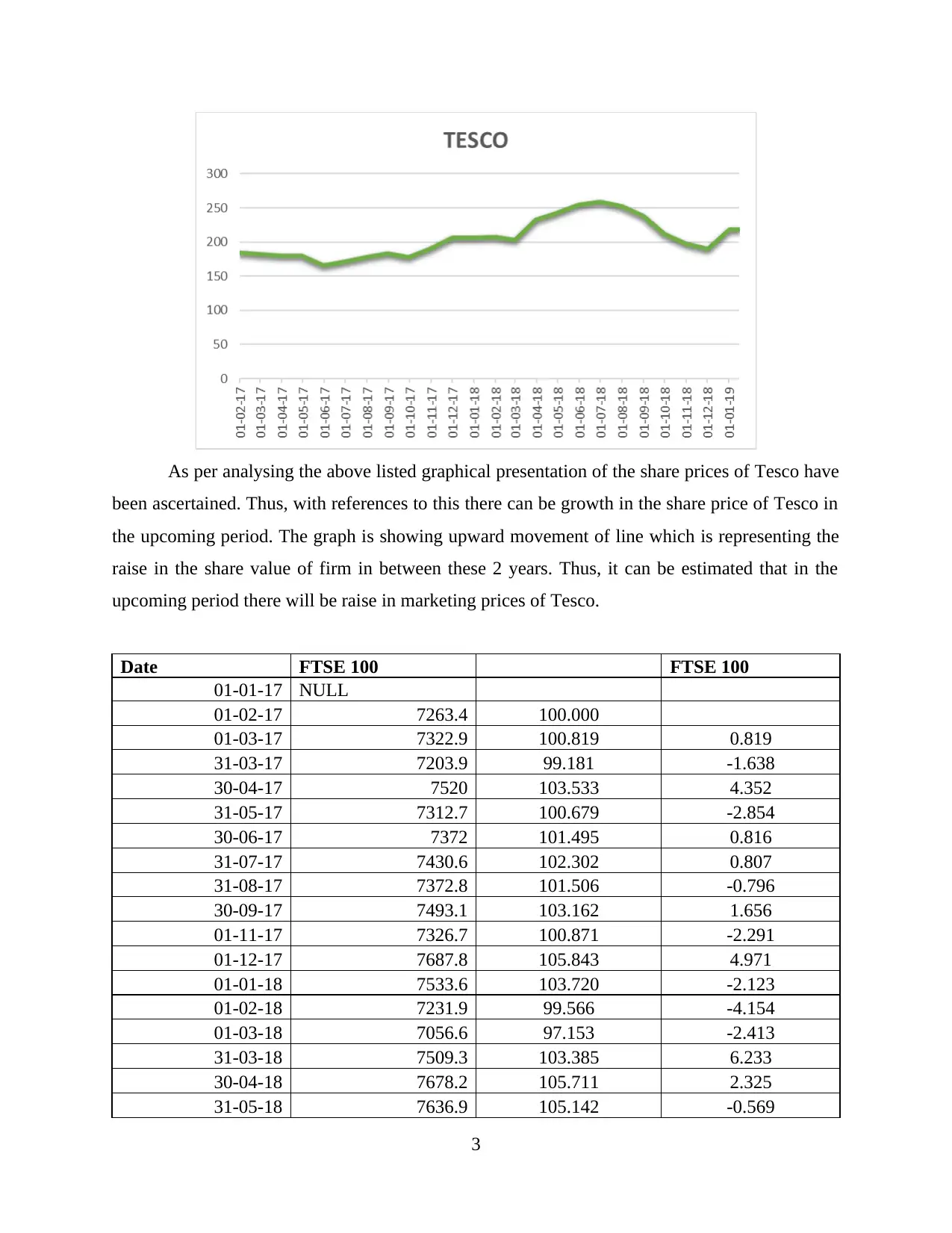
As per analysing the above listed graphical presentation of the share prices of Tesco have
been ascertained. Thus, with references to this there can be growth in the share price of Tesco in
the upcoming period. The graph is showing upward movement of line which is representing the
raise in the share value of firm in between these 2 years. Thus, it can be estimated that in the
upcoming period there will be raise in marketing prices of Tesco.
Date FTSE 100 FTSE 100
01-01-17 NULL
01-02-17 7263.4 100.000
01-03-17 7322.9 100.819 0.819
31-03-17 7203.9 99.181 -1.638
30-04-17 7520 103.533 4.352
31-05-17 7312.7 100.679 -2.854
30-06-17 7372 101.495 0.816
31-07-17 7430.6 102.302 0.807
31-08-17 7372.8 101.506 -0.796
30-09-17 7493.1 103.162 1.656
01-11-17 7326.7 100.871 -2.291
01-12-17 7687.8 105.843 4.971
01-01-18 7533.6 103.720 -2.123
01-02-18 7231.9 99.566 -4.154
01-03-18 7056.6 97.153 -2.413
31-03-18 7509.3 103.385 6.233
30-04-18 7678.2 105.711 2.325
31-05-18 7636.9 105.142 -0.569
3
been ascertained. Thus, with references to this there can be growth in the share price of Tesco in
the upcoming period. The graph is showing upward movement of line which is representing the
raise in the share value of firm in between these 2 years. Thus, it can be estimated that in the
upcoming period there will be raise in marketing prices of Tesco.
Date FTSE 100 FTSE 100
01-01-17 NULL
01-02-17 7263.4 100.000
01-03-17 7322.9 100.819 0.819
31-03-17 7203.9 99.181 -1.638
30-04-17 7520 103.533 4.352
31-05-17 7312.7 100.679 -2.854
30-06-17 7372 101.495 0.816
31-07-17 7430.6 102.302 0.807
31-08-17 7372.8 101.506 -0.796
30-09-17 7493.1 103.162 1.656
01-11-17 7326.7 100.871 -2.291
01-12-17 7687.8 105.843 4.971
01-01-18 7533.6 103.720 -2.123
01-02-18 7231.9 99.566 -4.154
01-03-18 7056.6 97.153 -2.413
31-03-18 7509.3 103.385 6.233
30-04-18 7678.2 105.711 2.325
31-05-18 7636.9 105.142 -0.569
3
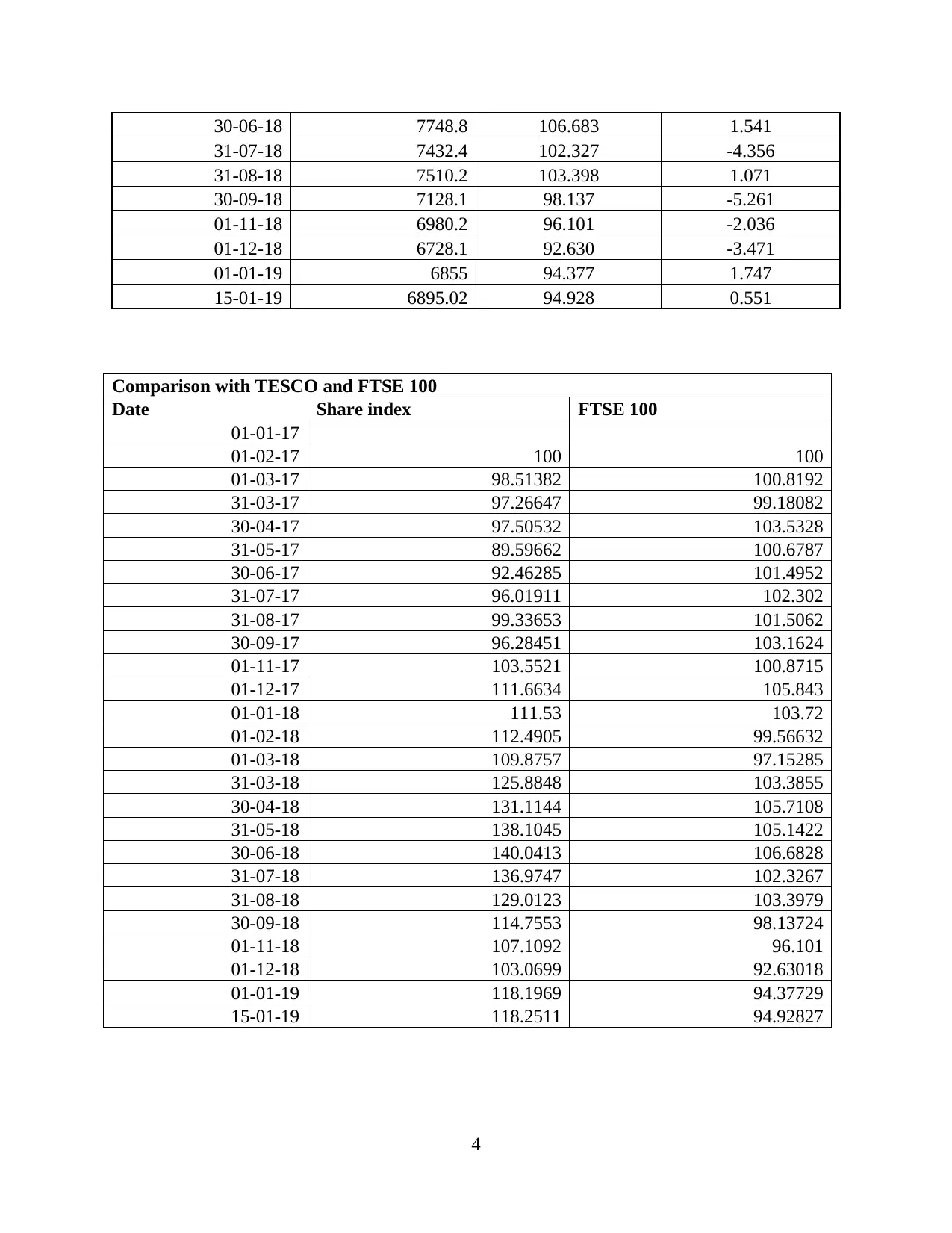
30-06-18 7748.8 106.683 1.541
31-07-18 7432.4 102.327 -4.356
31-08-18 7510.2 103.398 1.071
30-09-18 7128.1 98.137 -5.261
01-11-18 6980.2 96.101 -2.036
01-12-18 6728.1 92.630 -3.471
01-01-19 6855 94.377 1.747
15-01-19 6895.02 94.928 0.551
Comparison with TESCO and FTSE 100
Date Share index FTSE 100
01-01-17
01-02-17 100 100
01-03-17 98.51382 100.8192
31-03-17 97.26647 99.18082
30-04-17 97.50532 103.5328
31-05-17 89.59662 100.6787
30-06-17 92.46285 101.4952
31-07-17 96.01911 102.302
31-08-17 99.33653 101.5062
30-09-17 96.28451 103.1624
01-11-17 103.5521 100.8715
01-12-17 111.6634 105.843
01-01-18 111.53 103.72
01-02-18 112.4905 99.56632
01-03-18 109.8757 97.15285
31-03-18 125.8848 103.3855
30-04-18 131.1144 105.7108
31-05-18 138.1045 105.1422
30-06-18 140.0413 106.6828
31-07-18 136.9747 102.3267
31-08-18 129.0123 103.3979
30-09-18 114.7553 98.13724
01-11-18 107.1092 96.101
01-12-18 103.0699 92.63018
01-01-19 118.1969 94.37729
15-01-19 118.2511 94.92827
4
31-07-18 7432.4 102.327 -4.356
31-08-18 7510.2 103.398 1.071
30-09-18 7128.1 98.137 -5.261
01-11-18 6980.2 96.101 -2.036
01-12-18 6728.1 92.630 -3.471
01-01-19 6855 94.377 1.747
15-01-19 6895.02 94.928 0.551
Comparison with TESCO and FTSE 100
Date Share index FTSE 100
01-01-17
01-02-17 100 100
01-03-17 98.51382 100.8192
31-03-17 97.26647 99.18082
30-04-17 97.50532 103.5328
31-05-17 89.59662 100.6787
30-06-17 92.46285 101.4952
31-07-17 96.01911 102.302
31-08-17 99.33653 101.5062
30-09-17 96.28451 103.1624
01-11-17 103.5521 100.8715
01-12-17 111.6634 105.843
01-01-18 111.53 103.72
01-02-18 112.4905 99.56632
01-03-18 109.8757 97.15285
31-03-18 125.8848 103.3855
30-04-18 131.1144 105.7108
31-05-18 138.1045 105.1422
30-06-18 140.0413 106.6828
31-07-18 136.9747 102.3267
31-08-18 129.0123 103.3979
30-09-18 114.7553 98.13724
01-11-18 107.1092 96.101
01-12-18 103.0699 92.63018
01-01-19 118.1969 94.37729
15-01-19 118.2511 94.92827
4
⊘ This is a preview!⊘
Do you want full access?
Subscribe today to unlock all pages.

Trusted by 1+ million students worldwide
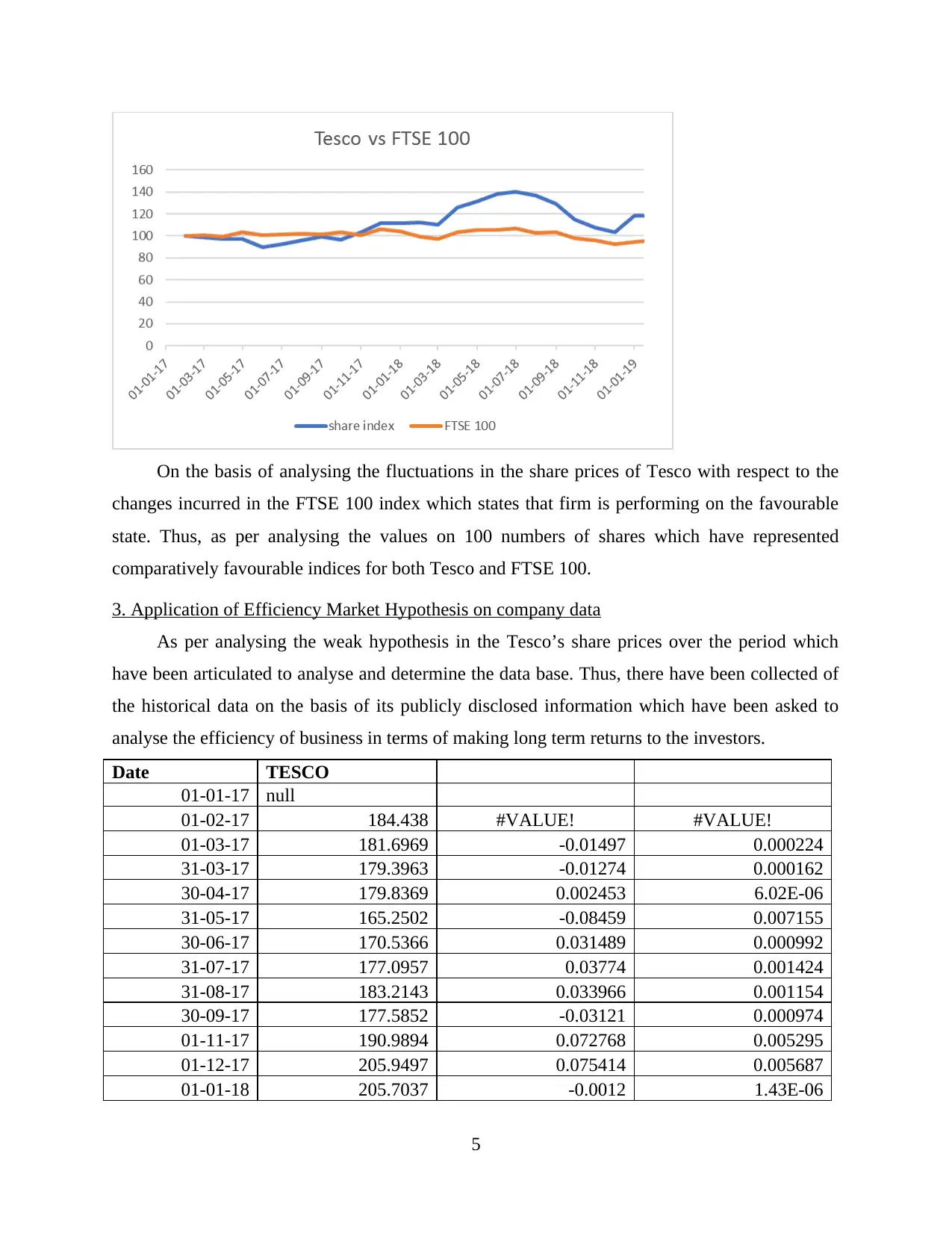
On the basis of analysing the fluctuations in the share prices of Tesco with respect to the
changes incurred in the FTSE 100 index which states that firm is performing on the favourable
state. Thus, as per analysing the values on 100 numbers of shares which have represented
comparatively favourable indices for both Tesco and FTSE 100.
3. Application of Efficiency Market Hypothesis on company data
As per analysing the weak hypothesis in the Tesco’s share prices over the period which
have been articulated to analyse and determine the data base. Thus, there have been collected of
the historical data on the basis of its publicly disclosed information which have been asked to
analyse the efficiency of business in terms of making long term returns to the investors.
Date TESCO
01-01-17 null
01-02-17 184.438 #VALUE! #VALUE!
01-03-17 181.6969 -0.01497 0.000224
31-03-17 179.3963 -0.01274 0.000162
30-04-17 179.8369 0.002453 6.02E-06
31-05-17 165.2502 -0.08459 0.007155
30-06-17 170.5366 0.031489 0.000992
31-07-17 177.0957 0.03774 0.001424
31-08-17 183.2143 0.033966 0.001154
30-09-17 177.5852 -0.03121 0.000974
01-11-17 190.9894 0.072768 0.005295
01-12-17 205.9497 0.075414 0.005687
01-01-18 205.7037 -0.0012 1.43E-06
5
changes incurred in the FTSE 100 index which states that firm is performing on the favourable
state. Thus, as per analysing the values on 100 numbers of shares which have represented
comparatively favourable indices for both Tesco and FTSE 100.
3. Application of Efficiency Market Hypothesis on company data
As per analysing the weak hypothesis in the Tesco’s share prices over the period which
have been articulated to analyse and determine the data base. Thus, there have been collected of
the historical data on the basis of its publicly disclosed information which have been asked to
analyse the efficiency of business in terms of making long term returns to the investors.
Date TESCO
01-01-17 null
01-02-17 184.438 #VALUE! #VALUE!
01-03-17 181.6969 -0.01497 0.000224
31-03-17 179.3963 -0.01274 0.000162
30-04-17 179.8369 0.002453 6.02E-06
31-05-17 165.2502 -0.08459 0.007155
30-06-17 170.5366 0.031489 0.000992
31-07-17 177.0957 0.03774 0.001424
31-08-17 183.2143 0.033966 0.001154
30-09-17 177.5852 -0.03121 0.000974
01-11-17 190.9894 0.072768 0.005295
01-12-17 205.9497 0.075414 0.005687
01-01-18 205.7037 -0.0012 1.43E-06
5
Paraphrase This Document
Need a fresh take? Get an instant paraphrase of this document with our AI Paraphraser
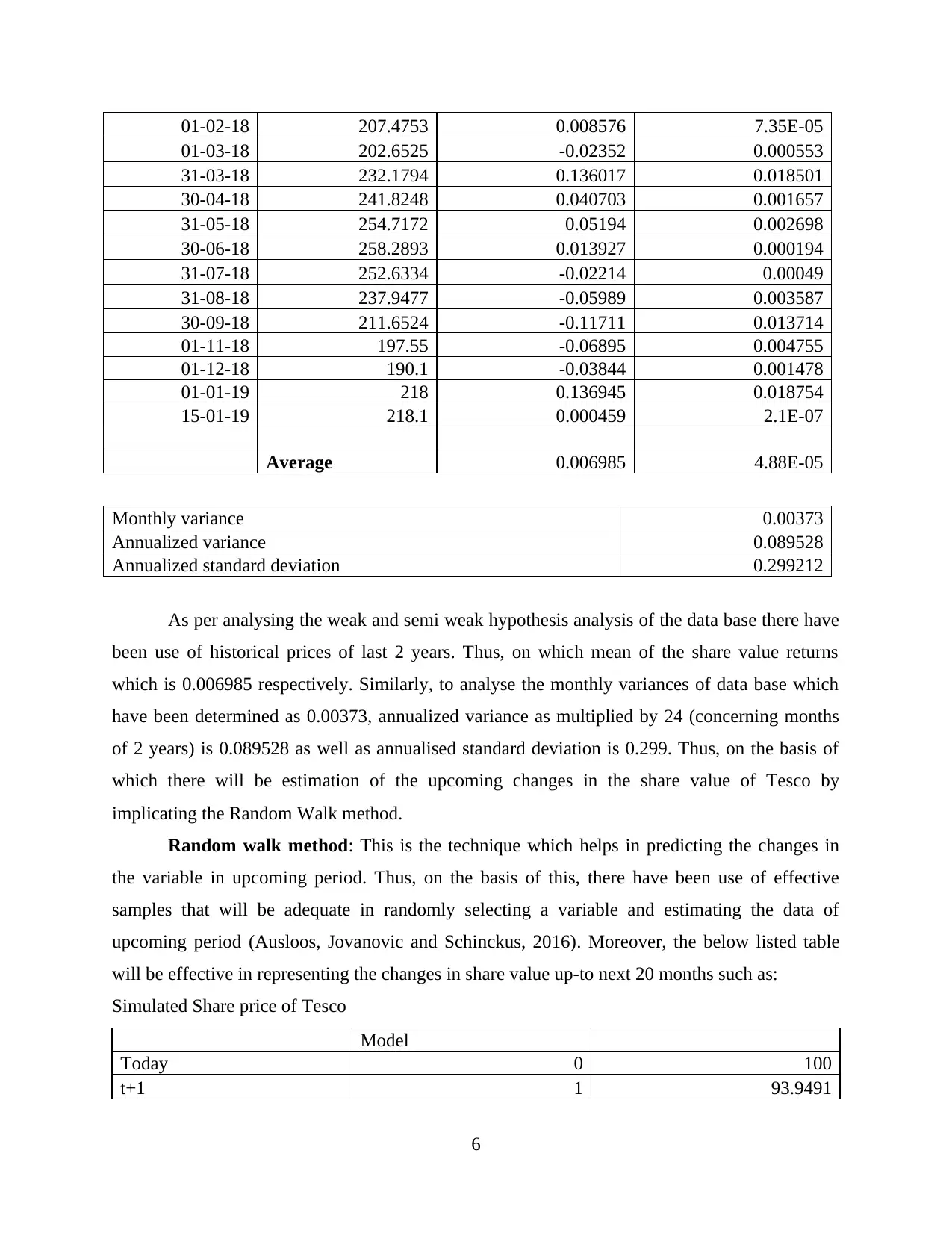
01-02-18 207.4753 0.008576 7.35E-05
01-03-18 202.6525 -0.02352 0.000553
31-03-18 232.1794 0.136017 0.018501
30-04-18 241.8248 0.040703 0.001657
31-05-18 254.7172 0.05194 0.002698
30-06-18 258.2893 0.013927 0.000194
31-07-18 252.6334 -0.02214 0.00049
31-08-18 237.9477 -0.05989 0.003587
30-09-18 211.6524 -0.11711 0.013714
01-11-18 197.55 -0.06895 0.004755
01-12-18 190.1 -0.03844 0.001478
01-01-19 218 0.136945 0.018754
15-01-19 218.1 0.000459 2.1E-07
Average 0.006985 4.88E-05
Monthly variance 0.00373
Annualized variance 0.089528
Annualized standard deviation 0.299212
As per analysing the weak and semi weak hypothesis analysis of the data base there have
been use of historical prices of last 2 years. Thus, on which mean of the share value returns
which is 0.006985 respectively. Similarly, to analyse the monthly variances of data base which
have been determined as 0.00373, annualized variance as multiplied by 24 (concerning months
of 2 years) is 0.089528 as well as annualised standard deviation is 0.299. Thus, on the basis of
which there will be estimation of the upcoming changes in the share value of Tesco by
implicating the Random Walk method.
Random walk method: This is the technique which helps in predicting the changes in
the variable in upcoming period. Thus, on the basis of this, there have been use of effective
samples that will be adequate in randomly selecting a variable and estimating the data of
upcoming period (Ausloos, Jovanovic and Schinckus, 2016). Moreover, the below listed table
will be effective in representing the changes in share value up-to next 20 months such as:
Simulated Share price of Tesco
Model
Today 0 100
t+1 1 93.9491
6
01-03-18 202.6525 -0.02352 0.000553
31-03-18 232.1794 0.136017 0.018501
30-04-18 241.8248 0.040703 0.001657
31-05-18 254.7172 0.05194 0.002698
30-06-18 258.2893 0.013927 0.000194
31-07-18 252.6334 -0.02214 0.00049
31-08-18 237.9477 -0.05989 0.003587
30-09-18 211.6524 -0.11711 0.013714
01-11-18 197.55 -0.06895 0.004755
01-12-18 190.1 -0.03844 0.001478
01-01-19 218 0.136945 0.018754
15-01-19 218.1 0.000459 2.1E-07
Average 0.006985 4.88E-05
Monthly variance 0.00373
Annualized variance 0.089528
Annualized standard deviation 0.299212
As per analysing the weak and semi weak hypothesis analysis of the data base there have
been use of historical prices of last 2 years. Thus, on which mean of the share value returns
which is 0.006985 respectively. Similarly, to analyse the monthly variances of data base which
have been determined as 0.00373, annualized variance as multiplied by 24 (concerning months
of 2 years) is 0.089528 as well as annualised standard deviation is 0.299. Thus, on the basis of
which there will be estimation of the upcoming changes in the share value of Tesco by
implicating the Random Walk method.
Random walk method: This is the technique which helps in predicting the changes in
the variable in upcoming period. Thus, on the basis of this, there have been use of effective
samples that will be adequate in randomly selecting a variable and estimating the data of
upcoming period (Ausloos, Jovanovic and Schinckus, 2016). Moreover, the below listed table
will be effective in representing the changes in share value up-to next 20 months such as:
Simulated Share price of Tesco
Model
Today 0 100
t+1 1 93.9491
6
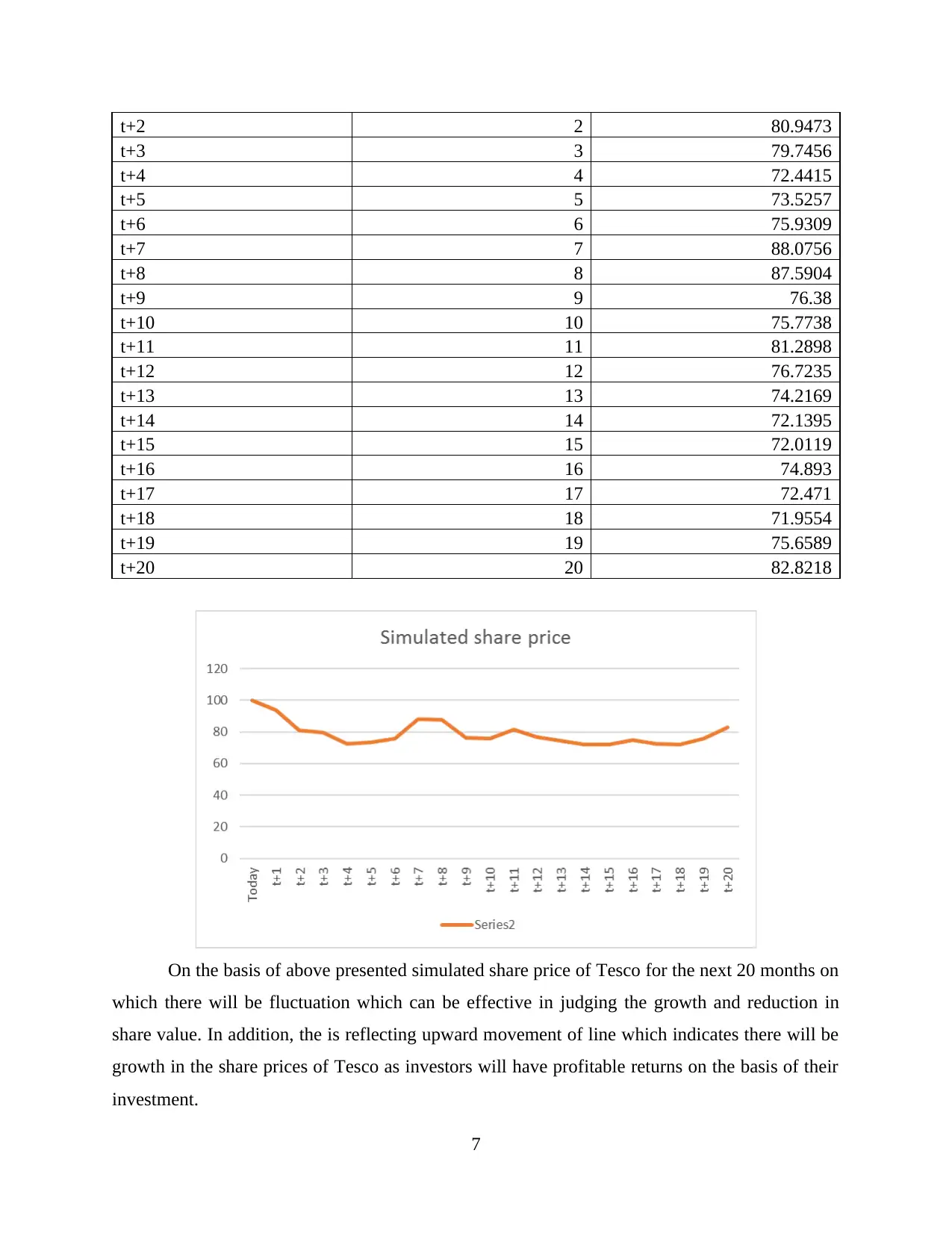
t+2 2 80.9473
t+3 3 79.7456
t+4 4 72.4415
t+5 5 73.5257
t+6 6 75.9309
t+7 7 88.0756
t+8 8 87.5904
t+9 9 76.38
t+10 10 75.7738
t+11 11 81.2898
t+12 12 76.7235
t+13 13 74.2169
t+14 14 72.1395
t+15 15 72.0119
t+16 16 74.893
t+17 17 72.471
t+18 18 71.9554
t+19 19 75.6589
t+20 20 82.8218
On the basis of above presented simulated share price of Tesco for the next 20 months on
which there will be fluctuation which can be effective in judging the growth and reduction in
share value. In addition, the is reflecting upward movement of line which indicates there will be
growth in the share prices of Tesco as investors will have profitable returns on the basis of their
investment.
7
t+3 3 79.7456
t+4 4 72.4415
t+5 5 73.5257
t+6 6 75.9309
t+7 7 88.0756
t+8 8 87.5904
t+9 9 76.38
t+10 10 75.7738
t+11 11 81.2898
t+12 12 76.7235
t+13 13 74.2169
t+14 14 72.1395
t+15 15 72.0119
t+16 16 74.893
t+17 17 72.471
t+18 18 71.9554
t+19 19 75.6589
t+20 20 82.8218
On the basis of above presented simulated share price of Tesco for the next 20 months on
which there will be fluctuation which can be effective in judging the growth and reduction in
share value. In addition, the is reflecting upward movement of line which indicates there will be
growth in the share prices of Tesco as investors will have profitable returns on the basis of their
investment.
7
⊘ This is a preview!⊘
Do you want full access?
Subscribe today to unlock all pages.

Trusted by 1+ million students worldwide
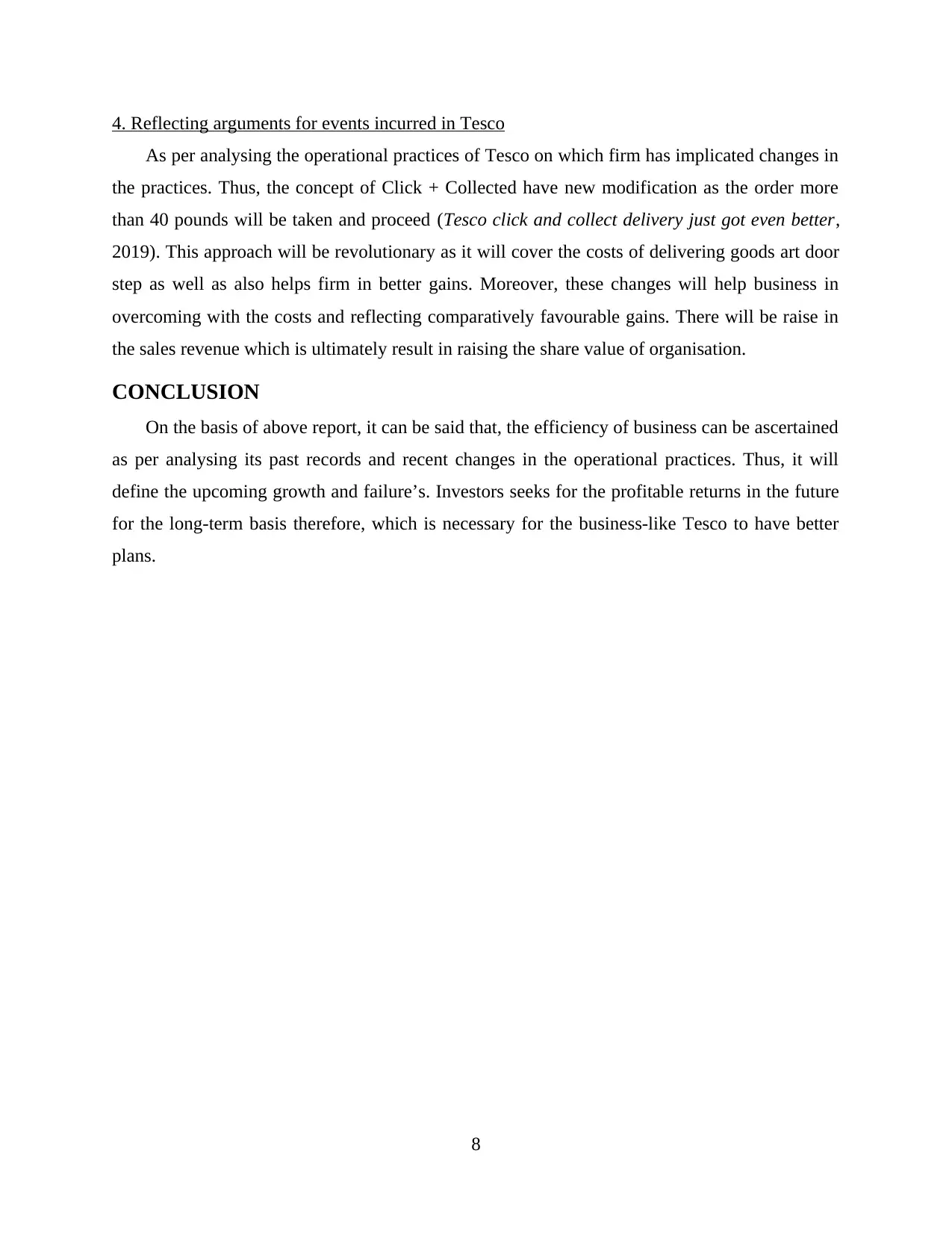
4. Reflecting arguments for events incurred in Tesco
As per analysing the operational practices of Tesco on which firm has implicated changes in
the practices. Thus, the concept of Click + Collected have new modification as the order more
than 40 pounds will be taken and proceed (Tesco click and collect delivery just got even better,
2019). This approach will be revolutionary as it will cover the costs of delivering goods art door
step as well as also helps firm in better gains. Moreover, these changes will help business in
overcoming with the costs and reflecting comparatively favourable gains. There will be raise in
the sales revenue which is ultimately result in raising the share value of organisation.
CONCLUSION
On the basis of above report, it can be said that, the efficiency of business can be ascertained
as per analysing its past records and recent changes in the operational practices. Thus, it will
define the upcoming growth and failure’s. Investors seeks for the profitable returns in the future
for the long-term basis therefore, which is necessary for the business-like Tesco to have better
plans.
8
As per analysing the operational practices of Tesco on which firm has implicated changes in
the practices. Thus, the concept of Click + Collected have new modification as the order more
than 40 pounds will be taken and proceed (Tesco click and collect delivery just got even better,
2019). This approach will be revolutionary as it will cover the costs of delivering goods art door
step as well as also helps firm in better gains. Moreover, these changes will help business in
overcoming with the costs and reflecting comparatively favourable gains. There will be raise in
the sales revenue which is ultimately result in raising the share value of organisation.
CONCLUSION
On the basis of above report, it can be said that, the efficiency of business can be ascertained
as per analysing its past records and recent changes in the operational practices. Thus, it will
define the upcoming growth and failure’s. Investors seeks for the profitable returns in the future
for the long-term basis therefore, which is necessary for the business-like Tesco to have better
plans.
8
Paraphrase This Document
Need a fresh take? Get an instant paraphrase of this document with our AI Paraphraser
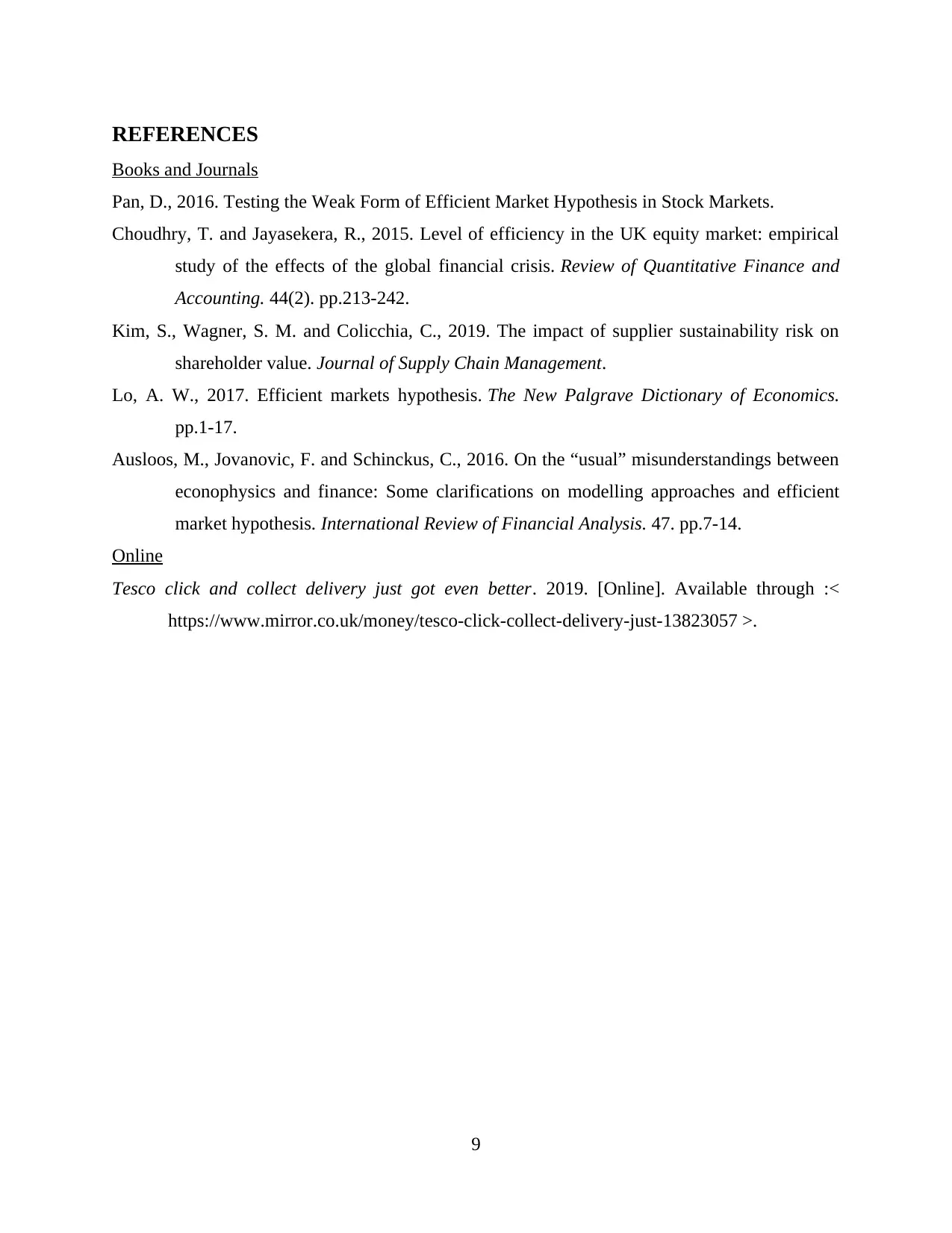
REFERENCES
Books and Journals
Pan, D., 2016. Testing the Weak Form of Efficient Market Hypothesis in Stock Markets.
Choudhry, T. and Jayasekera, R., 2015. Level of efficiency in the UK equity market: empirical
study of the effects of the global financial crisis. Review of Quantitative Finance and
Accounting. 44(2). pp.213-242.
Kim, S., Wagner, S. M. and Colicchia, C., 2019. The impact of supplier sustainability risk on
shareholder value. Journal of Supply Chain Management.
Lo, A. W., 2017. Efficient markets hypothesis. The New Palgrave Dictionary of Economics.
pp.1-17.
Ausloos, M., Jovanovic, F. and Schinckus, C., 2016. On the “usual” misunderstandings between
econophysics and finance: Some clarifications on modelling approaches and efficient
market hypothesis. International Review of Financial Analysis. 47. pp.7-14.
Online
Tesco click and collect delivery just got even better. 2019. [Online]. Available through :<
https://www.mirror.co.uk/money/tesco-click-collect-delivery-just-13823057 >.
9
Books and Journals
Pan, D., 2016. Testing the Weak Form of Efficient Market Hypothesis in Stock Markets.
Choudhry, T. and Jayasekera, R., 2015. Level of efficiency in the UK equity market: empirical
study of the effects of the global financial crisis. Review of Quantitative Finance and
Accounting. 44(2). pp.213-242.
Kim, S., Wagner, S. M. and Colicchia, C., 2019. The impact of supplier sustainability risk on
shareholder value. Journal of Supply Chain Management.
Lo, A. W., 2017. Efficient markets hypothesis. The New Palgrave Dictionary of Economics.
pp.1-17.
Ausloos, M., Jovanovic, F. and Schinckus, C., 2016. On the “usual” misunderstandings between
econophysics and finance: Some clarifications on modelling approaches and efficient
market hypothesis. International Review of Financial Analysis. 47. pp.7-14.
Online
Tesco click and collect delivery just got even better. 2019. [Online]. Available through :<
https://www.mirror.co.uk/money/tesco-click-collect-delivery-just-13823057 >.
9
1 out of 11
Related Documents
Your All-in-One AI-Powered Toolkit for Academic Success.
+13062052269
info@desklib.com
Available 24*7 on WhatsApp / Email
![[object Object]](/_next/static/media/star-bottom.7253800d.svg)
Unlock your academic potential
Copyright © 2020–2025 A2Z Services. All Rights Reserved. Developed and managed by ZUCOL.





